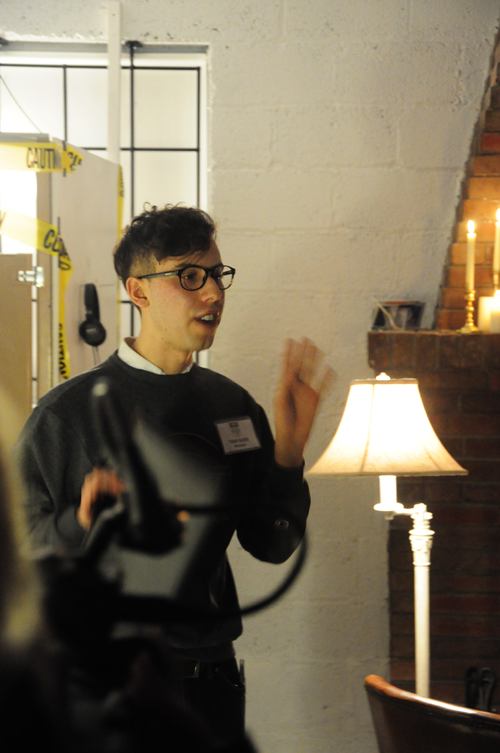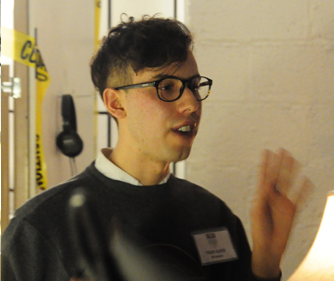
The boilerplate image for “#FOLLOWUS,” a collaborative multimedia installation on display at the University of Chicago’s Gray Center, is a still from the original short film “Urban Renewal.” Focusing the shot on the intersection of 55th Street and Lake Park Avenue, a hand behind the camera reaches forward and holds a photo print over the view. Drawn from the fifties, the five-by-seven reveals a thriving boulevard. Drawn again from the sixties, the space becomes sparser, shorter, and grimmer. The rows of cars are dispersed, the multi-storied storefronts blotted away, the makings of today’s squat, square shopping center get grafted onto the corner.
As an exhibition, “#FOLLOWUS” does much the same work as “Urban Renewal.” The show spotlights understated themes from the University’s growth and maturation. It juxtaposes them, gets them to talk to one another, and ultimately propels a paper archive into the warm-blooded world. You can practically trace a straight line from “Renewal’s” wall monitor to the table featuring “Future Nobel Laureates.” The table’s laid with a grid of unclaimed nametags for the University’s extant laureates, curated by two presentation posterboards. “Renewal” concludes by pointedly quoting the Southeast Chicago Commission’s former director, Julian Levi: “We are either going to have graduate students who produce leadership…or we are not going…to disturb existing owners and populations.” The illustrious ranks of “Laureates” conspicuously realize Levi’s dream, trumpeting the dubiously happy upshot to his leveling program.
Yet by channeling the science fair and the conference booth, the poster boards looming over “Laureates” undermine their own display. They make the accomplishment of eighty-nine total inductees tentative. Titles like “The Impact of the Common App,” or “How Many Chicago Dropouts Does it Take to Change American Culture?” preface abstracts, hypotheses, and methods. They question the likelihood that this number will swell into the future, or make lasting contributions. It’s worth noting that not a single tag is missing from the table. No gaps suggest that no laureates have returned to take up their badges (of honor). “Laureates” accordingly hints at the disinterest of homegrown talent in its hometown context. What’s worse: Nametags like these are a too-common sight at the check-in desks to major fundraising receptions. The symbol sinisterly associates any potential return with lucre.
In 1903, Sophonisba Breckinridge became the UofC’s first woman doctorate. In 1971, the Wieboldt building’s men’s bathroom became the premiere spot in Chicago for anonymous sex. “#FOLLOWUS” asks us to take these facts side by side. The exhibition credibly twins the coziness of Breckinridge’s fireplace with the communality of a toilet stall. The two installations reproduce each location, nestling them together in a corner. “Dear Love” puts Breckinridge’s tender letters to Dean Marion Talbot on display. The half-cracked desk drawer is as revealing as the electrician’s-taped glory holes drilled into the “Wieboldt Bathroom” partition. The works express two different modes of witty, graphic love. One scratches it out onto paper; the other scrawls it out with varicolored Sharpie. Both facelessly share an unsanctioned intimacy.
Participating artist and UofC Mellon Fellow Chase Joynt doesn’t think these comparisons revise the past. “This is mirroring the way the archive is functioning in the University,” he says. These disparate episodes and their “incomplete folklore” shared the same settings and now inhabit the same shelves, collections, and portfolios. Aiming to literally populate the Gray Center with the past, Joynt worked several distinct performance art routines into the exhibition. “It’s pushing back against the textual presentation of the history,” he says.
The sexual subtexts in the Breckinridge-Wieboldt binary come alive between the Faculty Wives and the WITCHes. Gallery-goers approach four women, animate anachronisms split between two booths: a bake sale conducted by professorial housewives, and a table of agitators from the Women’s International Terrorist Conspiracy from Hell. Two wear modest, patterned dresses, straightjacketing gender in strained smiles. Two militate for the rehire of Marxist professor Marlene Dixon. Approaching living history makes its messiness starker and more persistent. On opening night, both pairs actively solicited collections towards their causes. The activists’ donation jar to “stop female apology syndrome” was considerably sparser than the cash box for the wives’ cupcake sales. The crowd apparently just couldn’t resist crumbly cookies for the good of the cause.
Joynt also cited the performance component as a mechanism for helping out folks that “aren’t engaging with conceptual art” too frequently. Ten-minute gallery talks in the guise of “campus tours” road-mapped the room. The tours were deliberately “not didactic and explanative,” claimed Joynt. “How do we make the gallery space more accessible?” he asked instead. “What are some ways we can gesture to it to encourage exploration?” The tour itself read like a wholesale critique of actual campus walkthroughs, condemning the real tours’ pretention to an accurate snapshot of the University. It peppered its audiences with trumped up trivia, rigorously washing the record of the more colorful incidents that “#FOLLOWUS” concentrates and canvases.
As the show attempted to chart out the University’s unfrequented history—to embody questions of progress or violence, public or private, straight or queer—the University’s gallery mapped demands onto the show. A technical requirement to working in the Gray Center involves keeping its center clear. “#FOLLOWUS” became a kind of breathing metaphor for the UofC itself; the displays all necessarily hugged the walls, leaving the middle vacant. Occupied instead by the opening night’s chattering crowd, thinking and drinking, a conversational focal point developed, ringed by a periphery of strident narratives and rumbling challenges.
Gray Center for Arts and Inquiry, 929 E. 60th St. Through March 7. Monday-Friday, 11am-4pm. (773)834-1936. graycenter.

